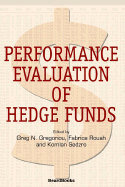|
|
|
|
||||||

|
Performance Evaluation of Hedge Funds
A collection of incisive articles revealing current methods for selecting and
monitoring hedge funds. Publisher Comments
Since the first hedge fund in 1949, the number of such funds has grown substantially. Hedge funds can be a valuable risk management tool when used properly because they can protect an investment in various situations. The incisive quantitative and qualitative analyses of hedge funds collected here by the editors reveal some current methods of hedge fund tracking and evaluation. This is vital for proper selection and monitoring of such funds. The emphasis of the book is on practical interpretation and applicability rather than on theory. This book will prove invaluable for all who wish to become versed in this form of an alternative investment, and particularly for those already investing and who want to monitor performance. From Turnarounds and Workouts: Hedge funds can be traced back to 1949 when Alfred Winslow Jones formed the first one to “hedge” his investments in the stock market by betting that some stocks would go up and others down. However, it has only been within the past decade that hedge funds have exploded in growth. The rise of global markets and the uncertainties that have arisen from the valuation of different currencies have given a boost to hedge funds. In 1998, there were approximately 3,500 hedge funds, managing capital of about $150 billion. By mid-2006, 9,000 hedge funds were managing $1.2 trillion in assets. Despite their growing prominence in the investment community, hedge funds are only vaguely understood by most people. Performance Evaluation of Hedge Funds addresses this shortcoming. The book describes the structure, workings, purpose, and goals of hedge funds. While hedge funds are loosely defined as “funds with no rules,” the editors define these funds more usefully as “privately pooled investments, usually structured as a partnership between the fund managers and the investors.” The authors then expand upon this definition by explaining what sorts of investments hedge funds are, the work of the managers, and the reasons investors join a hedge fund and what they are looking for in doing so. For example, hedge funds are characterized as an “important avenue for investors opting to diversify their traditional portfolios and better control risk” – an apt characterization considering their tremendous growth over the last decade. The qualifications to join a hedge fund generally include a net worth in excess of $1 million; thus, funds are for high net-worth individuals and institutional investors such as foundations, life insurance companies, endowments, and investment banks. However, there are many individuals with net worths below $1 million that take part in hedge funds by pooling funds in financial entities that are then eligible for a hedge fund. This book discusses why hedge funds have become “notorious as speculating vehicles,” in part because of highly publicized incidents, both pro and con. For example, George Soros made $1 billion in 1992 by betting against the British pound. Conversely, the hedge fund Long-Term Capital Management (LTCP) imploded in 1998, with losses totalling $4.6 billion. Nonetheless, these are the exceptions rather than the rule, and the editors offer statistics, studies, and other research showing that the “volatility of hedge funds is closer to that of bonds than mutual funds or equities.” After clarifying what hedge funds are and are not, the book explains how to analyze hedge fund performance and select a successful hedge fund. It is here that the book has its greatest utility, and the text is supplemented with graphs, tables, and formulas. The analysis makes one thing clear: for some investors, hedge funds are an investment worth considering. Most have a demonstrable record of investment performance and the risk is low, contrary to common perception. Investors who have the necessary capital to invest in a hedge fund or readers who aspire to join that select club will want to absorb the research, information, analyses, commentary, and guidance of this unique book. Greg N. Gregoriou teaches at U. S. and Canadian universities and does research for large corporations. Fabrice Rouah also teaches at the university level and does financial research. Komlan Sedzro is a professor of finance at the University of Quebec and an advisor to the Montreal Derivatives Exchange. From BookNews: This is a collection of articles designed to shed light on the cryptic world of the hedge fund. The articles are technical and drawn from journals, but not impenetrable: to benefit from them a reader will need some background in finance, but not a doctorate. Essentially, this is a practical primer for potential hedge fund investors, who tend to be mutual fund managers, endowments, or rich individuals, so a familiarity with finance is not an unreasonable expectation. Frustratingly, there are no authors associated with the articles; an acknowledgment section lists journal associations and possible authors, but gives no way to match authors to specific articles. Annotation ©2004 Book News, Inc., Portland, OR
|
|||||||||||||||||||||||||||||||||||||||||||||||||||||||||||||||||||||||||||
|
|
|
home
| about
us | contact
us | related
sites |